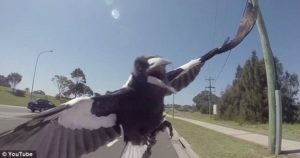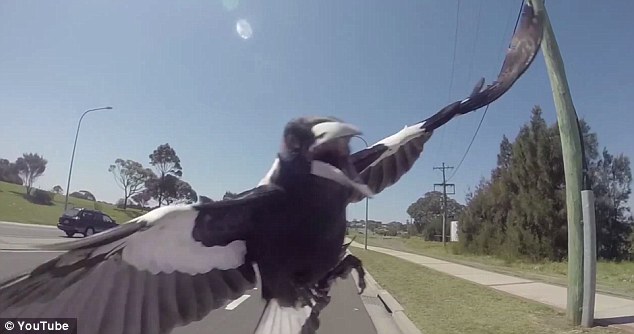How to avoid magpie attack while riding your bike
 I was rudely reminded on Sunday morning that at this time of year you need to avoid magpie attack while riding your bike, when an angry bird swooped me, clipping the back of my helmet. While he did me no harm, I could have overreacted and crashed my bike!!
I was rudely reminded on Sunday morning that at this time of year you need to avoid magpie attack while riding your bike, when an angry bird swooped me, clipping the back of my helmet. While he did me no harm, I could have overreacted and crashed my bike!!
You see it’s Spring in my home town of Sydney, and while it’s an awesome time of the year to ride a bike, it also means that there are a lot of angry birds swooping cyclists in the next couple of months.
Magpies seem to get most of the mentions, but in my local area there are a couple of very vicious butcherbirds that re-emerge at this time of year to protect their babies.
Native birds such as Australian Magpies are highly protective of their eggs, nest and young and will often swoop at unsuspecting passers-by if they feel threatened. Other native Australian birds that are also common culprits include butcherbirds, kookaburras and plovers, but even invasive species like Indian Mynas can attack at this time of year. Magpies seem to cop the majority of the blame but from my experience butcherbirds are more vicious.
Only a small proportion of birds swoop on people and these often have a preference for a few individuals that the birds recognise or certain types of ‘targets’ like cyclists. A magpie will only defend its nest within a ‘defence zone’. For cyclists, this is usually an area within 150 metres.
Almost all swoops on people are carried out by male birds defending their eggs and chicks, which are in the nest for about six to eight weeks between July and November. They will usually target the head but learn that helmets are there to protect the rider so start to side swoop attacking ears, cheeks and even eyes.
New research has found magpies are able to use facial recognition to determine who they target.
Griffith University behavioural ecologist Dr Darryl Jones said magpies were able to recognise people by their facial features, remember people who regularly passed through their territory, and could distinguish between those different people.
Dr Jones said while it could feel like magpies everywhere were bloodthirsty, only a small portion of magpies actually attacked people.
“Only around 10 per cent of magpies attack, and of that about half of them target pedestrians. The remaining half go for either cyclists or posties and there’s a very, very small group of magpies that just attack everybody,” said Dr Jones. Good news indeed.
Most people get more injury from falling off the bike or into oncoming traffic than the actual bird attack so it’s important to stay calm and keep riding.
Here’s a few tips that might help:
- Consider taking a different route if you know where a ‘swooping’ bird is nesting
- They generally only attack solo cyclists so ride in a tight bunch (not always practical because there’s always going to be a certain amount of riding when you’re on your own)
- Wear sunglasses to protect your eyes
- You may choose to dismount to avoid danger from traffic or from a fall. Once you have dismounted, look at the bird directly; magpies and other birds usually won’t attack when you are watching them
- Share the information about locations of attacking birds with fellow cyclists via social media, forums and websites. I found a good one where you can report bird attacks called Magpie Alert. You could also share the information on Facebook pages for your local cycling group and other ways you communicate with fellow cyclists.
Here’s what doesn’t work:
- Painting eyes on your helmet is not very effective as magpies have good eyesight and can learn the difference between painted and real eyes
- Putting cable ties on your helmet that stick up to deflect the swooping bird doesn’t appear to work. I’ve found no conclusive evidence in my research and frankly I’d rather take the risk than look like a dork.

